How to get rid of condensate in the ventilation pipe: the subtleties of eliminating drops from the duct
You have equipped a ventilation system, but still there is nothing to breathe in the house, and even damp? So, it's time to think about how to get rid of condensate in the ventilation pipe and prevent its formation in the future. Agree, it’s better to solve the problem right away than to endure discomfort for a long time.
We will tell you what to do so that you do not have to spend money on replacing ventilation pipes and combating mold in living rooms. From our article, you will learn how to better prevent and prevent condensation. Independent home craftsmen will help our recommendations.
The content of the article:
- What is condensate and what harm does it bring?
- Condensate removal outside ventilation ducts
- Requirements for Thermal Insulation Materials
- Acceptable thermal insulation options
- Features of insulating the duct from the inside
- The procedure for installing insulation on the outside
- Condensate control by example
- Installation of a new ventilation system
- Conclusions and useful video on the topic
What is condensate and what harm does it bring?
In the air masses in a vaporous state there is water. When cooled, the steam is converted into liquid water and settles on the inner surfaces of the air ducts in the form of droplets that can drain, forming streams and puddles.
Causes of condensation:
- errors in the design and installation of a ventilation system;
- increased humidity in the rooms;
- the proximity of water bodies;
- a large temperature difference inside and outside the house.
Of concern should not only puddles on the floor, but also rust on the pipes, a decrease in the influx of fresh air, moisture accumulation in the walls and ceilings through which air ducts are laid.
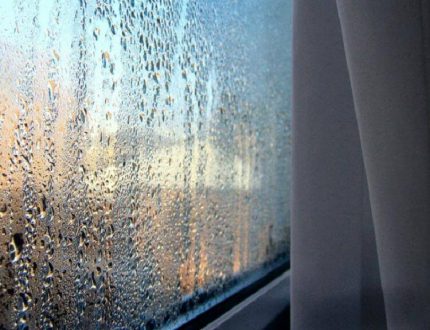
Condensate is a source of dampness in the house. It serves as the soil for the development of mold and other microorganisms that adversely affect human health. Under the influence of ventilation condensate, metal ducts are destroyed. Even concrete walls can not "feel" the harmful effects of high humidity.
Condensate removal outside ventilation ducts
Condensation is collected in the vertical and inclined sections of the ducts in their lower part. On horizontal ducts, condensate collection can be organized almost anywhere, except for sections laid in the walls.
AT vent pipe the tee is installed so that the branch is directed downward. The tap is equipped with a special tank - a condensate collector.
You can find in the free sale condensate collectors for ventilation of various types. They differ in design and materials. They can be transparent, which facilitates control over filling, but more often they are made of stainless or galvanized steel.
Tanks with a screw cap when filling with condensate are emptied manually, which is not always convenient. Moreover, at an outdoor temperature of -20º C and below, condensate is formed especially abundantly and the tank is filled in a short period of time.
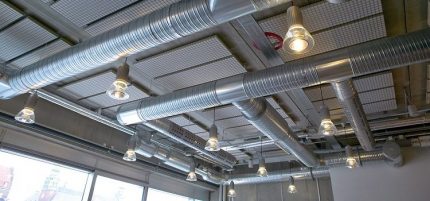
In this case, a conical condensate collector can is a good option. It is easy to attach a hose to it and drain condensate into the sewer. If it is necessary to organize fluid drainage in a hard-to-reach place, a model with a watering can is also used.
When organizing the collection and disposal condensate take into account the configuration of the ventilation system. With multiple pipe turns, you will have to install not one, but several condensate collectors.
Sorbents - moisture-holding substances also help to collect and remove condensate. They have the form of cartridges and are installed in the filtration section of the supply air duct. Periodically, the sorbent must be removed for drying, after which it is again ready for use.
Condensate removal is considered a temporary measure, primarily due to the possibility of ice plugs in winter. Warming up vetkanals helps radically solve the problem.
Requirements for Thermal Insulation Materials
To insulate the air ducts in the ventilation system, materials are required that have the following properties:
- low thermal conductivity;
- vapor tightness;
- fire resistance;
- sound absorbing ability;
- biostability.
The coefficient of thermal conductivity is the most important parameter of the insulating material.

The second most important indicator is vapor permeability. Many materials used for insulation of ventilation have the ability to release moisture accumulated under them when exceeding the maximum voltage for them.
Filling the pores of the material, moisture increases its thermal conductivity, thereby reducing the efficiency of insulation. To prevent this from happening, a waterproofing coating is mounted on top of the heat insulator - a membrane that can let steam out, blocking access to it.
From fire resistance depends on how heat insulation will be fireproof. In total there are 6 classes of fire resistance.
For air ducts, a zero class insulation is required, that is, having the highest fire resistance, and therefore, the most fireproof. With multilayer thermal insulation and the fulfillment of a number of additional conditions, the use of materials of the first class of fire resistance is allowed
Passing through the air ducts, air flow creates noise. In forced ventilation systems, a running fan also makes noise and vibrates. To prevent noise and vibration from being transmitted through rigid structures and not spreading through living quarters, damping devices and gaskets are used.
But most heat-insulating materials have soundproofing properties and, in addition to their main function, help protect the house from unpleasant acoustic effects.
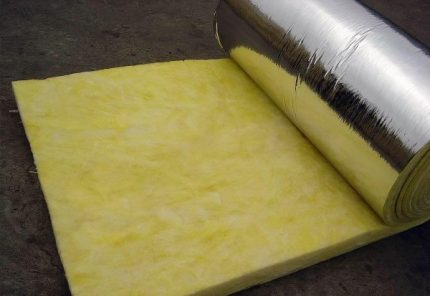
The materials used should not be a favorable environment for the life of insects, molds, causing rotting bacteria and other harmful microorganisms.
Penetrating through the air ducts into the living quarters, they can cause diseases and also damage the material itself, which may require its premature replacement. There are microorganisms whose metabolic products are so aggressive that they can burn steel sheets 1.5 mm thick.
The materials used in the arrangement of ventilation communications must comply with sanitary and hygienic standards. The insulation must not emit substances hazardous to humans and the environment. Environmental friendliness means the absence of a threat of environmental contamination during disposal.
Acceptable thermal insulation options
The above requirements are met by many mineral fiber materials, hydrocarbon polymers, foam elastomers, including:
- mineral wool;
- polyvinyl chloride;
- polystyrene foam;
- polyurethane.
Foam elastomers are obtained by extrusion and vulcanization. They have a porous structure, and the pores are bubble, that is, closed, which reduces moisture absorption and makes them vapor-proof. By polymerizing hydrocarbons, heaters such as polyurethane and polyvinyl chloride are obtained.
Thermal insulators are sold in the form of rolls, sheets (mats), hollow cylinders (shells). Roll materials and shells are suitable for thermal insulation of pipes and round ducts. Rectangular ducts can be insulated with sheet material.
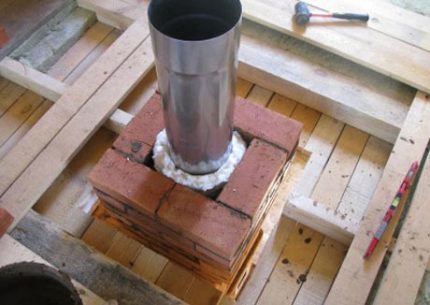
Sheet and roll heaters are highly flexible, it is easy to give them the necessary shape, one side of them can be smooth. Thanks to the combination of these properties, the installation of thermal insulation is greatly facilitated. Many materials are not only fireproof, but also self-extinguishing, which increases fire safety.
The insulation is selected taking into account the environmental conditions in which it will be used, including the operating temperature. For the middle zone of Russia, materials capable of withstanding the ambient temperature in the range from -30 ° C to 60 ° C are suitable for warming ventilation systems.
As a waterproofing protection, a polyethylene (PE) film and a polyvinyl chloride (PVC) membrane are used. Insulated ventilation ducts are closed from external damage by boxes, sheathed by a board, plywood or aluminum sheets.
Features of insulating the duct from the inside
It is necessary to insulate all air ducts located outside the heated rooms, including areas in the walls. It is possible to insulate both the external and internal surfaces of the ducts.
If the insulation is carried out from the inside, already at the design stage provide for an increase in the duct cross-section in accordance with the thickness of the insulation layer. Otherwise, its throughput will decrease.
Mineral wool fibers are reinforced with adhesives. This is necessary to prevent peeling of the fibers under the influence of a jet of air. The glue used for this purpose should not affect the level of fire resistance of the insulation and its environmental friendliness.
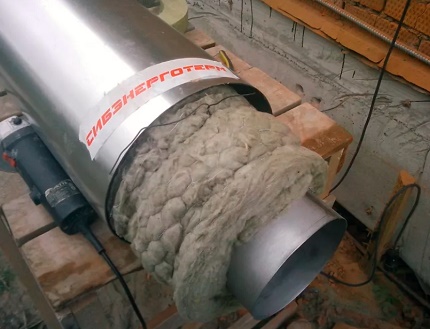
The thermal insulation laid on the inside should not increase aerodynamic drag, slowing the movement of air masses. That is, it is necessary to make its surface smooth.
Due to the additional requirements for internal thermal insulation, its use is often impractical. Including if you have to insulate already built ventilation system with a given section of the ducts. In such cases, the ducts are insulated from the outside.
The procedure for installing insulation on the outside
The most economical thermal insulation material for a private house is the time-tested mineral wool. It comes in the form of rolls of various widths and can have one or two outer foil layers.
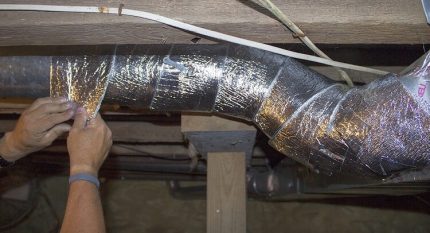
When determining the thickness of the insulating layer, they are guided by SNiP 2.04.14–88. Heat technicians perform complex calculations taking into account the diameters of the pipes, the coefficient of thermal conductivity of the used insulation material.
Take into account the average annual air temperature and even possible heat loss through joints and fastenings, as well as other parameters, most of which can be found in the directories and the above SNiP.
Speaking specifically about mineral wool, then when warming ventilation systems in private houses located in the middle zone of Russia, roll material 100 mm thick is usually used. You can buy mineral wool with a thickness of 50 mm and wrap the pipe twice.
To determine the desired width of the insulation, measure the diameter of the pipe, add the thickness of the mineral wool multiplied by two to the obtained value. Multiply the resulting amount by 3.14 (Pi).
Getting started, prepare in advance a rubber spatula, a construction knife, a stapler, aluminum tape 7-8 cm wide, a marker and measuring tools - a square, a ruler and a tape measure (preferably metal). Be sure to wear protective clothing.
For work in the open air, choose a day without precipitation. Otherwise, mineral wool may get wet. Roll, unfold, mark and cut, to get the segment you need size. The foil is separated along the edge so that the pipe can be wrapped with mineral wool with an overlap and the connecting seam is covered with a foil layer.
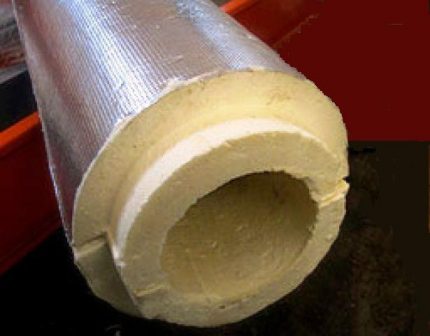
Then the connecting seam with a step of 10 cm is fixed with a stapler and glued with tape along the entire length. To fix the insulation to the pipe, both special fasteners and ordinary wire are used.
To protect the joints of the ducts, the insulation is cut into fragments of the corresponding shape and size. Do not forget to clean the pipe from contamination before insulation.
Warming can be done with the help of segmented heaters. The monolithic casing is in the form of a pipe and strung on the duct. It is used mainly during installation of the ventilation system from scratch.
Having measured the geometric parameters of the duct, they select a casing that is suitable in size and pull it along the entire length of the pipe. The foil is wound on top and fixed with stainless steel or copper clamps.
Collapsible shell consists of two half-cylinders, which are applied to the pipe from two sides and are fixed. In the sections passing through the wall, it is difficult to wrap the pipe in a roll insulation, and putting the shell on is much easier. Collapsible shell can be worn on an existing duct.
Condensate control by example
Consider a specific situation. In a one-story private house there is a ventilation system that provides air exchange in the bathroom and kitchen.Metal ventilation pipes are connected to these rooms.
They are laid in the attic with a subsequent exit to the roof. With daily temperature fluctuations, condensation forms in the pipes. But especially a large number of it is observed in winter, when water drips from the hood, gathering in a puddle.
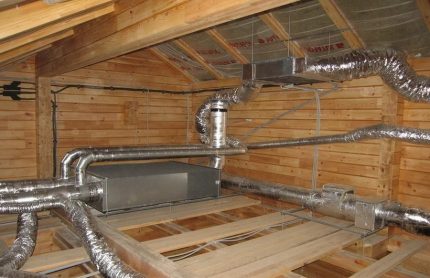
The problem is solved comprehensively. The insulation of the exhaust and supply pipe is carried out. The pipes are insulated, starting from the entrance to the ceiling and up to the outside. In areas passing through an unheated attic, pipes are insulated with roll mineral wool 70-100 mm thick.
In places of passage through the ceiling and ceiling, a shell is used. A tee with a condenser collector is installed at the lower point.
If ventilation ducts do not pass through the roof, but through the wall, a section in the wall is insulated with the help of a shell. Outside the house, a 90 degree tee is installed on the ventilation pipe, a condensate collector and an umbrella (deflector) are mounted.
Installation of a new ventilation system
Due to errors in design and installation, when using low-quality pipes, all condensate control measures may be in vain.
In this case, it is economically feasible to drown out the old one and equip a new ventilation system that would cope with its functions of removing contaminated and supplying fresh air masses.
Designing is carried out only after analysis of air exchange processes and calculations in accordance with the standards specified in SNiP, based on the characteristics of ventilated rooms and the number of residents. You may have to abandon natural ventilation in favor of forced ventilation with a change in the configuration of ventilation ducts and the installation of equipment for heating the supply air.
Conclusions and useful video on the topic
How to determine if condensation forms in the ducts:
Condensate outlet from the ventilation system to the sewer:
The installation of condensate collectors in combination with insulation of ventilation pipes solves several problems simultaneously. The rate of condensation is reduced.
That small amount of moisture, which nevertheless can condense on the surface of the duct, is quickly removed outside of it, without having time to do harm. The noise and vibration level is reduced, which is especially noticeable in forced ventilation systems. As a result, the microclimate is normalizing, the house is becoming more comfortable for living.
Do you have your own experience in dealing with condensate in ventilation pipes in a country house or in a country house? Do you know the technical nuances of its removal or prevention, which are worth sharing with site visitors? Please leave comments, post photos, ask questions in the block below.

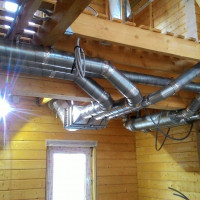 Condensation in ventilation in a private house: causes of moisture accumulation and ways to fix the problem
Condensation in ventilation in a private house: causes of moisture accumulation and ways to fix the problem 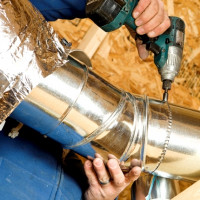 How to make ventilation in the country: subtleties and rules for installing ventilation of a country house
How to make ventilation in the country: subtleties and rules for installing ventilation of a country house 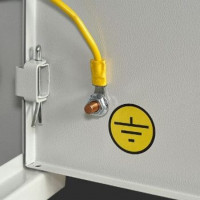 Grounding the ventilation system: rules and subtleties of the protective circuit device
Grounding the ventilation system: rules and subtleties of the protective circuit device 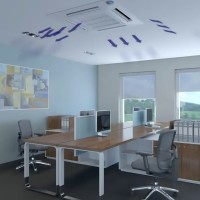 Duct-mounted ducted air conditioner: subtleties of choice and installation
Duct-mounted ducted air conditioner: subtleties of choice and installation 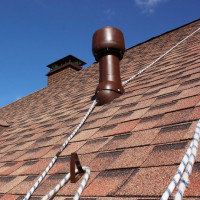 Ventilation on the roof of a private house: the construction of the passage of the duct through the roof
Ventilation on the roof of a private house: the construction of the passage of the duct through the roof 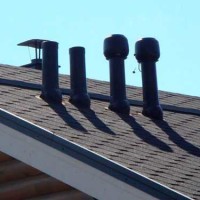 Adjoining the roof to the ventilation shaft: arrangement of the passage of the ventilation unit through the roof
Adjoining the roof to the ventilation shaft: arrangement of the passage of the ventilation unit through the roof  How much does it cost to connect gas to a private house: the price of organizing gas supply
How much does it cost to connect gas to a private house: the price of organizing gas supply  The best washing machines with dryer: model rating and customer tips
The best washing machines with dryer: model rating and customer tips  What is the color temperature of light and the nuances of choosing the temperature of the lamps to suit your needs
What is the color temperature of light and the nuances of choosing the temperature of the lamps to suit your needs  Replacement of a geyser in an apartment: replacement paperwork + basic norms and requirements
Replacement of a geyser in an apartment: replacement paperwork + basic norms and requirements